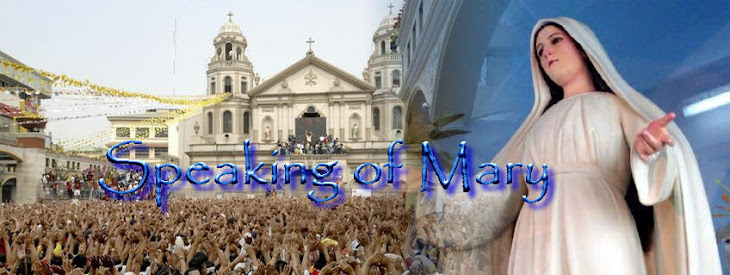BEFORE the dogma of the Divine Maternity of Mary was defined (which was defined in relation to the Divinity and Humanity of Christ), there were a number of heresies that propped up and were all related to the Person of Christ. Three of these main heresies are the following:
Docetism, derived from the Greek dokeo, “to seem.” It is the erroneous belief that Christ only seemed to be human, that He did not really have a body of human flesh. It denied the Incarnation; Christ did not really have Mary as His mother according to the flesh. It was one of the first theological errors to appear in Church history, for it is probably the target of the warning of 1 John 4:2,3: “Every spirit that confesses that Jesus Christ is come in the flesh is of God: and every spirit that confesses not that Jesus Christ is come in the flesh is not of God: and this is that spirit of antichrist, whereof ye have heard that it should come: and even now already it is in the world.”
Ignatius of Antioch (died 98/117) and Irenaeus (115-190), and Hippolatus (170-235) wrote against the error in the early part of the second century. Docetism was condemned at the Council of Chalcedon in 451.
Arianism was a Christian heresy first proposed early in the 4th century by the Alexandrian presbyter Arius. It affirmed that Christ is not truly divine but a created being. The fundamental premise of Arius was the uniqueness of God, who is alone self-existent and immutable. The Son, who is not self-existent, cannot be God.
Led by Athanasius, bishop of Alexandria, the council condemned Arianism and stated that the Son was consubstantial (of one and the same substance or being) and coeternal with the Father, a belief formulated as homoousios ("of one substance") against the Arian position of homoiousios ("of like substance"). Nonetheless, the conflict continued, aided by the conflicting politics of the empire after the death of Constantine (337).
Nestorianism is the error that Jesus is two distinct persons. The heresy is named after Nestorius, who was born in Syria and died in 451 AD, who advocated this doctrine. Nestorius was a monk who became the Patriarch of Constantinople and he repudiated the Marian title "Mother of God." He held that Mary was the mother of Christ only in respect to His humanity. The council of Ephesus was convened in 431 to address the issue and pronounced that Jesus was one person in two distinct and inseparable natures: divine and human. Nestorius was deposed as Patriarch and sent to Antioch, then Arabia, and then Egypt. Nestorianism survived until around 1300.
The problem with Nestorianism is that it threatens the atonement. If Jesus is two persons, then which one died on the cross? If it was the "human person" then the atonement is not of divine quality and thereby insufficient to cleanse us of our sins.
To address in particular the Nestorian heresy, the Church convoked the Council of Ephesus. The Council of Ephesus was held in 431 at the Church of Mary in Ephesus, Asia Minor. St. Cyril, Patriarch of Alexandria, appealed to Pope Celestine, charging Nestorius with heresy. The Pope agreed and gave Cyril his authority to serve a notice to Nestorius to recant his views or else be excommunicated. Before the summons arrived, Nestorius convinced the Emperor Theodosius II, to hold a General council, a platform to argue their opposing views. Approximately 200 bishops were present. The proceedings were conducted in a heated atmosphere of confrontation and recriminations. It is counted as the Third Ecumenical Council, and was chiefly concerned with Nestorianism.
In summary, Nestorius believed that Mary, the mother of Jesus gave birth to the incarnate Christ, not the divine Logos who existed before Mary and indeed before time itself. The Logos occupied the part of the human soul (the part of man that was stained by the Fall). But wouldn't the absence of a human soul make Jesus less human? No, Nestorius answered because the human soul was based on the archetype of the Logos only to become polluted by the Fall, therefore Jesus was "more" human for having the Logos and not "less". Consequently, Mary should be called Christotokos, Greek for the "Christ-Bearer" and not Theotokos, Greek for the "God-Bearer." Cyril argued that Nestorianism split Jesus in half and denied that he was both human and divine. This was essentially a Christological controversy.
At the urging of its president, Cyril of Alexandria, the Council denounced Nestorius' teaching as erroneous and decreed that Jesus was one person, not two separate people: complete God and complete man, with a rational soul and body. The Virgin Mary was to be called Theotokos because she bore and gave birth to God as a man. Nestorius was solemnly deposed and stripped of his Episcopal dignity. The decrees of the Council of Ephesus were later ratified by the delegates of Pope Celestine. The night on which the decrees were promulgated, crowds of the faithful took to the streets and shouted enthusiastically, Hagia Maria Theotokos, Holy Mary, Mother of God. Such cry that became the hallmark of Christian orthodoxy.
(Acknowledgments: Wikipedia, The Mystery of Mary: Rev. Dr. Paul Haffner)
Tuesday, September 30, 2008
Subscribe to:
Post Comments (Atom)


No comments:
Post a Comment